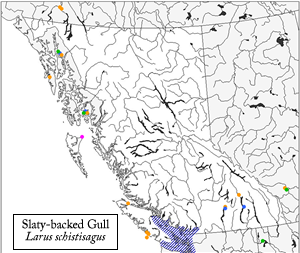Breeding adult
This plumage is held between ~March/April and ~September/October. The mantle, including the back, scapulars, and most of the upperwings, is dark slate-grey. The subterminal area and outer webs of the outer primaries are black, contrasting slightly with the dark grey mantle. The relatively broad white trailing edge to the secondaries and inner primaries extends as a series of white subterminal spots along the central primaries, known as a “string of pearls” pattern. The outermost primary has a single rectangular subterminal spot (“mirror”) and all primaries have small white tips, which are most visible at rest (sometimes absent in summer through wear). From below, the wings show a “ghost-pattern” of the upperwing pattern, including the “string of pearls”, but the dark blackish-grey wingtips are mostly restricted to the outer webs of the outer primaries. The rump, uppertail coverts, and tail are white, as are the head, neck, and entire underparts. The iris is pale yellow or sometimes amber-coloured, with a reddish orbital ring. The bill is heavy but relatively straight and is yellow with a red gonydeal spot. The legs and feet are bright pink.
Non-breeding adult
This plumage is held between ~September/October and ~March/April. It is similar to the breeding plumage, but the head and neck are variably (usually heavily) streaked and mottled with dusky grey-brown. These markings are often heaviest around the eyes, giving the species the appearance of a dark “smudge” through the eyes. The bill is paler and duller yellow than during the breeding season, often with a variable dark subterminal mark. The orbital ring, feet, and legs are also duller than in breeding plumage.
Third-year immature
This plumage is held between the fall of the third year and the spring of the fourth year, at which time a partial molt results in a “third-summer” plumage that last into the fall. It is overall similar to the non-breeding adult plumage but has heavier dark streaking and mottling on the head and neck, often extending onto the breast, underwing coverts, or even belly. The mantle retains a brownish tinge, especially over the upperwing coverts (which are often extensively brownish), and the tips of the primaries have reduced white spots at the tips and a smaller white “mirror” on the outermost primary. The tail typically sports a broken, irregular blackish subterminal band or, at the least, several small subterminal marks. The bill also retains some signs of immaturity, usually a more extensive blackish subterminal band or a pinkish wash at the base.
Second-year immature
This plumage is held between fall of the second year and spring of the third year, at which time a partial molt results in a “second-summer” plumage that lasts into the fall. In relation to the first-year immature plumages, this plumage shows a variable number of slate-grey feathers coming in on the back and scapulars. The primaries are darker and blackish, and the tertials are a similar blackish colour but have variable whitish, checkered fringes. The rump is whitish with sparse brown markings, and the tail shows more extensive white at the base and tip with a more isolated dark brown subterminal band. The head, neck, and underparts are whitish with relatively heavy dusky grey-brown streaking and mottling. The iris ranges from dark to pale dusky-yellow; the bill is blackish with an irregular dull pinkish base, and the legs and feet are pinkish. Over the course of the winter and into the spring, the head, neck, and underparts become whiter (often extensively white by spring), the upperparts become more extensively dark slate-grey, the upperwing coverts become whiter and bleached, and the rump and tail become whiter and more adult-like. Even at its whitest, the head retains a variable dark smudge around the eyes. The iris continues to become paler and yellowish and the pinkish base of the bill expands and becomes more extensive.
Juvenile / First-year immature
The juvenile/‘first-winter’ plumage is held until spring or early summer of the second year, at which time a partial molt produces a “first-summer” plumage that lasts until the fall. The upperparts are dark brown with paler buffy or whitish mottling and, in fresh plumage, fringes on the feathers. The rump and uppertail coverts are particularly heavily marked with whitish mottling. The flight feathers are dark blackish-brown with pale tips to the secondaries and darker tips and outer webs on the primaries; at rest, the primaries appear dark blackish-brown with very narrow, crescent-shaped paler fringes. The tail is blackish-brown, with some paler mottling at the bases of the outer feathers and, in fresh plumage, fine pale tips to the feathers. The head, neck, and underparts are brown with variable whitish mottling over the head, neck, and breast (usually retaining a darker brownish area, or “smudge”, around the eyes). The iris is dark, the bill is blackish, and the legs and feet are pinkish. Over the course of the first winter and into the following spring, the plumage gradually bleaches and becomes whiter, especially on the head, neck, underparts, back, scapulars, and wing coverts. As well, the base of the bill often begins to turn pinkish. Birds in their “first-summer” plumage often appear particularly bleached and pale, with heavily worn feathers.
Measurements
Total Length: 60-65 cm
Mass: 1,350 g
Source: Olsen and Larsson (2004); Howell and Dunn (2007)

